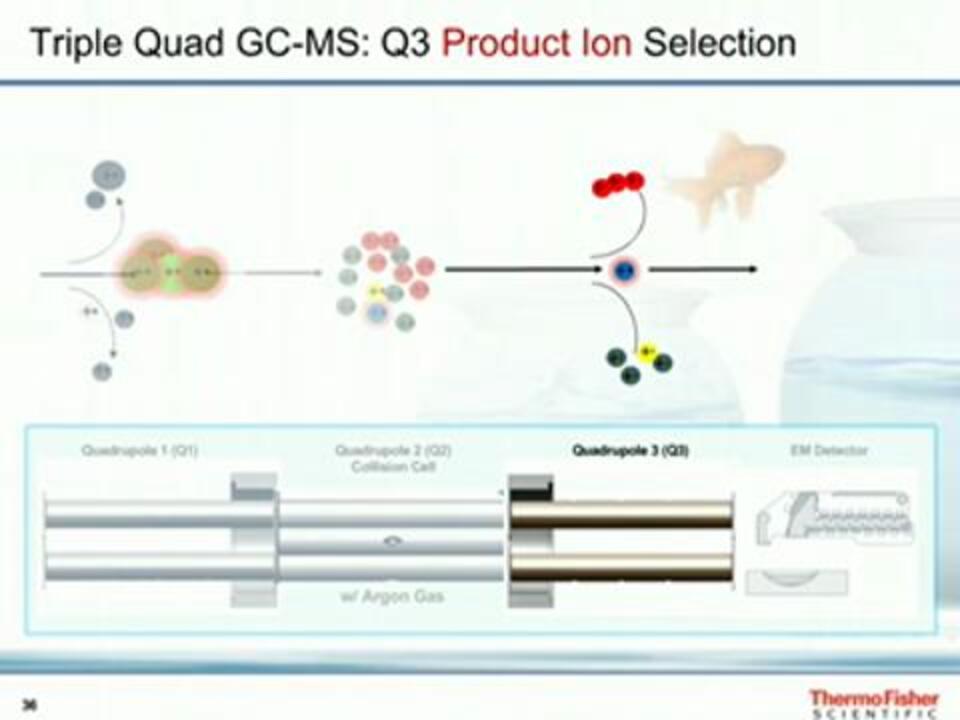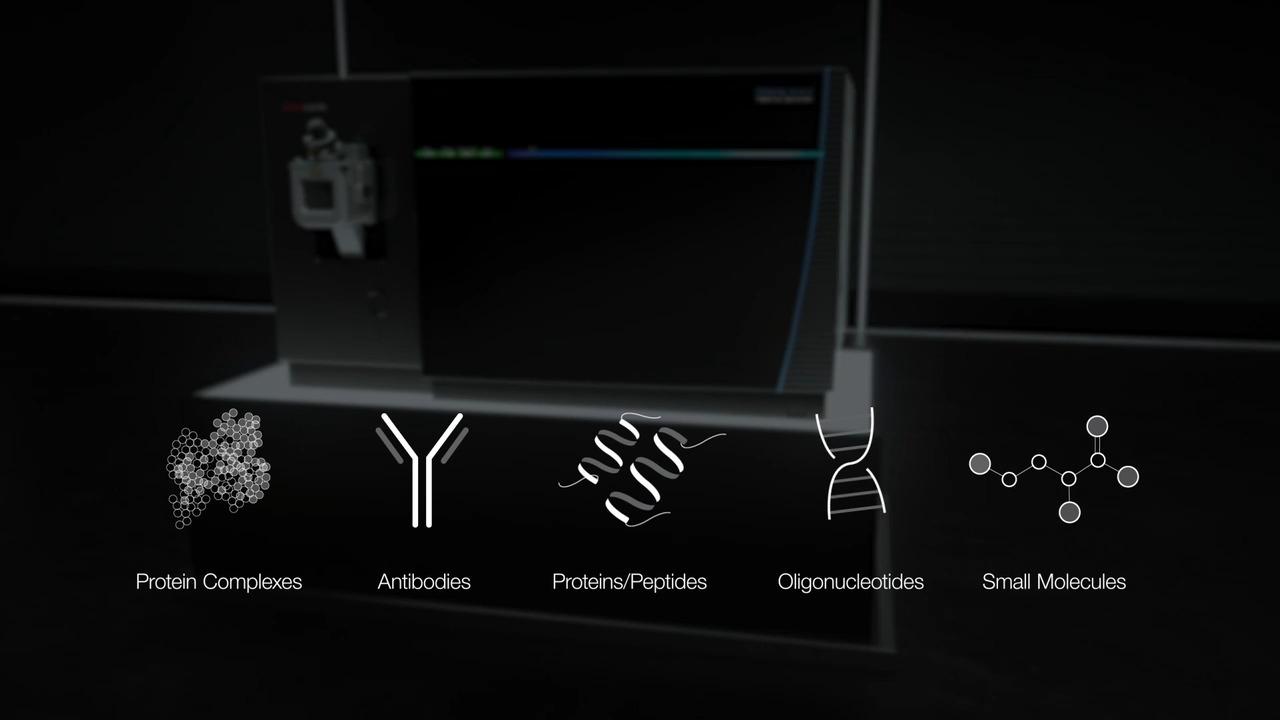Search Thermo Fisher Scientific

What is mass spectrometry?
Mass spectrometry (MS) involves four basic steps: ionization, ion separation by a mass analyzer, detection, and data processing and analysis. In modern mass spectrometers, these steps are managed by computer software. Following ionization, analytes are transmitted into the vacuum chamber of the mass spectrometer. Here, the mass analyzer separates the ions based on their mass-to-charge ratios (m/z). The The detector generates a signal representative of ion abundance at specific values of m/z, and this signal is processed and recorded by computer software by a detector and the resulting signal is measured and recorded by computer software.
Using certain MS technologies, tandem MS can be performed by isolating and imparting precursor ions with internal energy to cause dissociation, resulting in fragment ions which are then measured as a MS/MS fragment ion spectrum. Tandem MS is often abbreviated as MS/MS or MS2. Additionally, specific MS/MS product ions can be isolated and dissociated into a higher order product ion spectrum (referred to as MS3). This process can be repeated to obtain additional levels of MS (referred to as MSn). When combined with chromatography, such as liquid, ion, or gas chromatography, MS and MSn are powerful analytical tools for compound identification and quantitation.
Topics in mass spectrometry
Related resources
Ionization
Atoms and molecules must be ionized before they can be separated in the mass analyzer and detected by their mass-to-charge ratio (m/z). Ionization methods include atmospheric pressure chemical ionization (APCI), atmospheric pressure photo ionization (APPI), electron ionization (EI), electrospray ionization (ESI), chemical ionization (CI), inductively coupled plasma (ICP) ionization, and matrix-assisted laser desorption/ionization (MALDI). Different ionization methods are used depending on the sample characteristics and experimental goals.
Types of mass analyzers
Examples of mass analyzers include single quadrupole, triple quadrupole, quadrupole ion trap, orbital electrostatic ion trap (e.g., the Thermo Scientific Orbitrap mass analyzer), Fourier transform ion cyclotron resonance (FT-ICR), magnetic sector, and time-of-flight (TOF). Different mass analyzers excel at different types of experiments. For example, quadrupoles are often used in quantitative studies, while ion traps are chosen for qualitative and structural work. Mass analyzers can also be combined to create tandem, hybrid or Thermo Scientific Tribrid mass spectrometers that perform advanced experiments or improve experimental results and throughput.
A quadrupole mass analyzer uses DC and RF voltages applied to four parallel rod electrodes to create electrical fields that selectively stabilize or destabilize the path of particular ions though the mass filter based on their m/z.
When a linear series of three quadrupoles is used, the resulting triple stage quadrupole analyzer is able to both filter and fragment the ion stream. In a typical mode of operation, the first (Q1) and third (Q3) quadrupoles act as mass filters, while the second (Q2) quadrupole dissociates ions by collision with a neutral gas such as argon, helium or nitrogen.
In this configuration, triple quadrupole MS systems can be operated to perform Selected Reaction Monitoring (SRM). SRM is a highly selective data acquisition mode where the set of DC and RF voltages applied to Q1 selectively transmit a narrow m/z range centered on the target precursor m/z value. Selected precursor ions exit Q1 into Q2 where the precursor ions collide with the neutral gas molecules, producing a series of product ions in the process known as collision-induced dissociation (CID). The product ions exit Q2 into Q3, where the narrow m/z ranges associated with a specific fragment ion are filtered for subsequent detection. The dwell time is the amount of time the triple quadrupole mass spectrometer measures ion intensity for this SRM transition and is typically around 10 milliseconds.
For targeted screening and quantitation, performing tandem MS using SRM significantly improves selectivity, sensitivity and, provided the product ions monitored are diagnostic of the target compound, the specificity needed for accurate and robust targeted quantitation. The additional selectivity obtained reduces the need for extensive sample preparation, increasing experimental productivity.
The level of selectivity offered by triple quadrupole systems is valuable for the analysis of target compounds in the fields of drug testing, food safety, environmental analysis, and clinical and forensic toxicology studies.
Historically, most quadrupole ion traps used in mass spectrometry are based on the model invented by Wolfgang Paul (who shared in the 1989 Nobel Prize). Known as a three-dimensional ion trap, the Paul-based ion trap uses frequency (RF) electrical fields to trap ions for analysis. These Ion traps utilize three electrodes with hyperbolic surfaces function to trap ions: two endcap electrodes and a central ring electrode. Ions may be scanned out of the trap in order of their m/z's by varying the amplitude of the trapping voltage over time, which causes ions of a particular m/z to develop unstable trajectories or to be resonantly ejected via use of a supplemental oscillatory field.
Quadrupole ion traps may alternatively be constructed with a two-dimensional geometry. Such traps, often referred to as "linear" ion traps, employ four rod electrodes arranged in parallel, and confine ions to an elongated central channel through the application of RF voltages to the rod electrodes (which provides confinement in the radial dimensions) and the application of DC voltages to end lenses or outer segments of the rod electrodes (which provides confinement in the axial dimension).
The ion trap’s stability offers high sensitivity and enables the selection and study of individual ion/molecule reactions through MSn. As a result, ion traps are well-suited for the discovery and targeted analysis of molecules and molecular reactions in fields such as metabolomics and lipidomics, as well as post-translational modification analysis.
The Orbitrap mass analyzer is an orbital electrostatic ion trap based on a modified Kingdon ion trap design. It consists of a central spindle-like electrode surrounded by an outer barrel-shaped electrode. The outer electrode is laterally split into two symmetrical halves. Electrostatic voltages are applied to either or both of the inner and outer electrodes, producing an electric field that causes ions injected into the annular space between the inner and outer electrodes to undergo orbital motion around the central electrode and harmonic "back and forth" motion along the dimension defined by the central axis. The frequency of harmonic motion is characteristic of the ions' m/z.
The back and forth motion of the trapped ions within the Orbitrap analyzer produces an image current on the split halves of the outer electrode, which is processed to determine the frequencies and abundances of the ons. The presence of hundreds or thousands of different ions of different m/z induces a very complex image current (sometimes referred to as a "transient"), which is resolved and converted into mass spectra using a mathematical process called Fourier transformation. The Orbitrap mass analyzer’s high-resolution capability is due to accurate measurement of frequencies at MHz rates combined with precise time measurements.
Orbitrap-based mass spectrometers are used for targeted and non-targeted analysis of a wide variety of applications that benefit from high-resolution/accurate mass analysis, including unknown compounds in areas of biomarker discovery, proteomics, metabolism, food safety and environmental testing, clinical research, and forensic toxicology.
Now a portfolio of three instruments designed to meet the needs of everyday research and analytical laboratories with next-level insights for scientific exploration and targeted quantitation. With performance and operational consistency, and market-leading resolving power, our next-generation, advanced high-resolution accurate-mass (HRAM) quadrupole-Orbitrap mass spectrometers deliver ease of use without sacrificing maximum performance.
What is a TOF mass analyzer?
A time-of-flight (TOF) mass analyzer separates ions of different masses based on their flight times over a known distance. Ions are created and then pulsed out with equal kinetic energy by an optical element into a flight tube. Because lighter ions travel faster than heavier ions of the same kinetic energy, the time of their arrival at the detector is used to determine m/z.
The quadrupole-TOF mass spectrometer combines a quadrupole mass filter (Q1) and a collision cell (Q2) with a TOF mass analyzer to produce MS/MS spectra. Q1 can be operated to transmit all ions or as a mass filter to select specific ions based on m/z. After leaving the collision cell, the ions are analyzed by TOF as described above.
What is a hybrid mass analyzer?
The various mass analyzers can be combined in one mass spectrometer to perform advanced experiments with different separation, resolution, and detection goals. For example, the Thermo Scientific Orbitrap Exploris 480 mass spectrometer includes a quadrupole mass filter to better select precursor ions prior to their injection into and HRAM detection by an Orbitrap mass analyzer. The Orbitrap mass analyzer can resolve spectral peaks having almost the same m/z values. Furthermore, this instrument contains an HCD collision cell to effectively fragment ions for unambiguous confirmation of molecular identities.
There are many other hybrid mass spectrometers that combine different mass analyzers, including the following:
- Q-TOF: quadrupole + time of flight (TOF)
- Q-Trap: quadrupole + ion trap
- Q Exactive mass spectrometer: quadrupole + Orbitrap mass analyzer
These hybrid mass spectrometers combine the best features of each mass analyzer, providing additional analytical performance and versatility.
Tribrid mass spectrometers like the Thermo Scientific Orbitrap Eclipse mass spectrometer combine quadrupole, linear ion trap, and Orbitrap mass analyzers for MS, MS2, MSn analyses which offer more fragmentation capabilities for deeper analysis of samples
Molecular dissociation
To better understand the structural characteristics of a molecule, a dissociation technique may be used to break it up into fragments prior to MS analysis. The additional fragment ion peaks provide a molecular "fingerprint" that can help a scientist to determine its molecular structure. In diagnostics and applied laboratories, several fragmentation stages may be used to confirm the identity of a compound. Learn more about molecular dissociation techniques.
Detection
After m/z-based analyzer in the mass filter, ions can be detected using a variety of detectors including electron multipliers, scintillators, conversion dynodes, or Faraday cups. In these cases, the detectors multiply the signal produced by the incident ions by producing elections and photons.
In addition, Orbitrap and certain other mass analyzers, ion detection is performed using an image current induced on the electrodes of the mass analyzer by ion motion. The complex image current is resolved and converted into mass spectra using Fourier transformation. This approach takes multiplexed measurements rather than direct measurement to provide an improvement in resolution and in signal to noise ratio (known as Fellgett's advantage).
Data processing and analysis
In addition to providing control of complex MS instrument and method parameters, computing software is used to perform data processing and to produce useful results from the vast amounts of raw MS data generated. There are numerous software tools available. The choice of software tools depends on the:
- Mass analyzer, e.g., quadrupole mass filter versus Orbitrap
- Type of sample analyzed, e.g., small versus large molecules or complex versus simple mixtures
- Goals of the analysis, e.g., compound identification versus quantitation
Evolution of Orbitrap mass spectrometry instrumentation
Learn how Orbitrap mass analyzer technology has revolutionized mass spectrometry for over a decade.

Understanding terminology in high-resolution, accurate-mass Orbitrap mass Spectrometry
What is resolving power versus resolution? Why is high mass accuracy important? Find out here.
Making the GC-MS triple transition with ease
Talk on how to make the transition from a single to a triple quadrupole GC-MS system and the advantages of this system.
Contact us
* Required field






